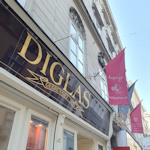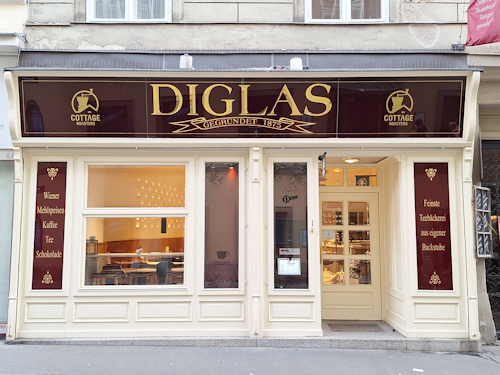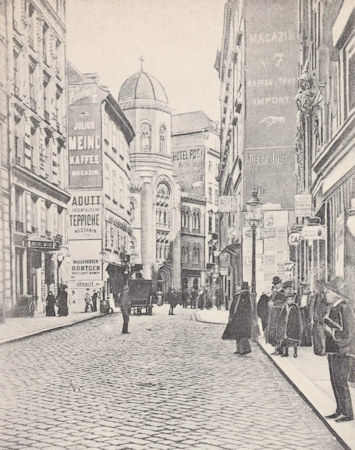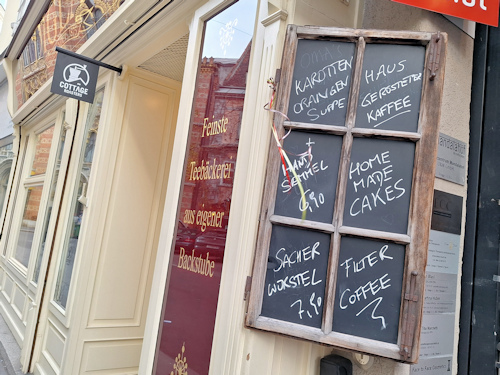
Buried in the midst of historical Vienna, but away from the crowds: the Cottage Roasters coffee shop “im kleinen Diglas” delivers an intimate mix of tradition with modern touches.
- Not far from the cathedral
- Go through to the back room
- Lovely local area worth a quick explore
- Reopened in late 2024
- Top cakes & specialty coffees
- Find a walking tour* for your Vienna trip
- See also:
Quietly historical

(Spot the coffee cup lighting feature lining one interior wall)
One of the curiosities of a historical town centre are those patches that carry the aura of the past but manage to avoid being overrun by visitors. Like the Fleischmarkt in Vienna: far enough away from the centre to avoid crowds, but close enough to reach easily on foot.
The street begins a hop, skip and jump northeast of Stephansdom cathedral and has, for example, several Jugendstil joys and the imposing Byzantine look of the Griechenkirche zur Heiligen Dreifaltigkeit church.
The predecessor to today’s Hotel Post Wien (at Fleischmarkt 24) hosted the likes of Mozart, Haydn, Nietzsche, and Chopin. Turn right at the eastern end of the road to find streets and buildings that stand in for 1900 Vienna in TV productions.
And yet the area remains (relatively) tranquil.

(Fleischmarkt sometime after 1904 with the Griechenkirche in the background; produced by Brüder Kohn KG (B. K. W. I.); Wien Museum Inv.-Nr. 105275/45, excerpt reproduced with permission under the terms of the CC0 licence)
Fleischmarkt translates to meat market, and the location’s use dates all the way back to at least the 1200s. At the time, coffee was still just a little-known (to Europeans) wild flower in Africa.
Jump forward a few centuries and house number 16 has been serving the beverage since 1875, now as the Cottage Roasters coffee shop in the Diglas premises. Sister coffee houses include the Diglas Wollzeile and Schottenstift locations.
The interior seems to mimic the broader Fleischmarkt ambience. Low vaulted ceilings hint at history and tradition, while the long, thin design takes you ever further away from any city hubbub.
The effect feels like you woke up in a past where all is not quite as it seems. Just as with the Wollzeile Diglas, it pays to take a closer look and find modern flair combined with tradition.
At the front: stylish stools and chairs along with weighty coffee house tables. Coffee cups decorate a wall near the entrance to create an innovative and stylish lighting effect.
At the rear: a more intimate layout with a book-lined niche and bucolic scenes covering patterned wallpaper. But an old gilded picture frame surrounds an avant garde black and white photo. And coffee cups hang from a glass chandelier.

(Cakes and coffee…what more can you ask for?)
A self-service location, the café has its own specialty coffees (my melange was excellent), craft beer and other drinks, baguettes, pastries and snacks, and cakes from the Diglas in-house patisserie.
In the past, we’ve consumed vast quantities of fine cake here. I resisted temptation on my last visit, but noticed the slices looked notably generous by current Viennese standards (especially the Schnitten).
Everything just feels very genuine. An opportunity to step aside from the whirl of city centre tourism without having to catch a tram to do so.

(Fleischmarkt has long offered sustenance to visitors. This c.1824 painting by Dietrich Monten shows Greeks and Turks in what may well be the “Zum weißen Ochsen” coffee house once located further down the road from Café Diglas; Wien Museum Inv.-Nr. 13493; excerpt reproduced under the terms of the CC BY 4.0 license; photo by Birgit and Peter Kainz, Wien Museum)
How to get there
As mentioned, you can easily walk up from the pedestrianised centre. Just leave the cathedral square (Stephansplatz) via Rotenturmstraße and turn right after a couple of streets to get onto Fleischmarkt.
Subway: a short stroll from Schwedenplatz station (on the U1 and U4 lines) or even the very central Stephansplatz station (U1 and U3)
Tram/bus: tram lines 1 and 2 also stop at Schwedenplatz. And the 2A old town bus service stops nearby, too (the Rotenturmstraße stop)
Address: Fleischmarkt 16, 1010 Vienna | Website